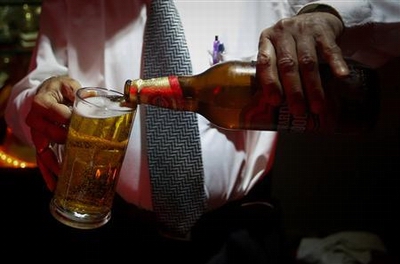
Billed as the world's first fruit-flavoured strong beer in its May launch, Tuborg Booster Strong is one of several potent brews that Carlsberg and rivals SABMiller, Anheuser-Busch Inbev and United Breweries are rolling out to make inroads in a market dominated by whisky.
Strong beer, with alcohol content of 5-8 percent, accounted for 83 percent of all beer sold in India last year, according to research firm Mintel, a figure industry players say is the biggest strong beer share of any major market. Brewers expect that to grow to 90 percent over the next three to five years.
Mintel expects India's retail beer market, worth more than 200 billion rupees ($3 billion) last year, to more than double by 2017 to 430 billion rupees, with volume growing 36 percent.
"Indian consumers are looking for choices away from whisky and need products that not only give them more bang for their buck, but also have a macho image," said Subodh Marwah, Carlsberg India's marketing director.
Alcohol content and price are important considerations in India, where incomes average just $1,000 per year and high state taxes make beer more expensive than whisky by alcohol volume.
For 100 rupees, or under $2, a consumer can buy 180 ml of 40 percent local whisky, which works out to about 1.3 rupees per ml of alcohol, said Samar Singh Shekhawat, senior vice president of marketing at United Breweries. The same amount will buy a 650 ml bottle of strong beer, but because of the lower alcohol levels, consumers pay over twice as much per ml.
"The reason for alcohol consumption in India is basically to get buzzed," Shekhawat said. "For us and for anyone, the focus has to be the strong category because this, unlike mild beer, sells right down the economic strata."
A masculine image is also key.
Only a third of India's 1.1 billion population drink regularly and most are men, which explains names like SABMiller's Knock Out and United Breweries' Bullet.
Last year, Anheuser-Busch Inbev launched its Budweiser Magnum, an India-only offering with 6.5 percent alcohol. Kingfisher Strong, with 8 percent alcohol and made by United Breweries, is India's best-selling beer.
Such beers are meant to appeal to customers like 34-year-old courier Raghunandan, who was sipping rum at a dingy Mumbai bar.
"Beer just doesn't do it for me," he said, asking to be identified by one name. "It's expensive, plus I don't feel like I had anything to drink."
Market Potential
Two-thirds of Indians don't drink alcohol at all, often for religious or cultural reasons, but rapid urbanisation, a young population and a fast-growing middle class are changing alcohol consumption habits, making India an attractive market for drinks companies.
Besides competing with whisky, strong beer is also trying to attract customers who normally drink so-called country liquor, a cheap tipple prevalent in villages.
Beer accounts for just 5 percent of alcohol consumed by volume in India, according to SABMiller. Per capita beer consumption averages 1.7 litres a year compared with 74 litres in the United States, according to United Breweries.
Overall alcoholic beverage sales in India are forecast by Euromonitor to rise up to 8 percent a year by volume through 2017.
This potential is especially attractive to global brewers looking to offset sluggish growth in their traditional strongholds of North America and Europe.
Carlsberg expects India to become one of the world's top 10 beer markets in the next five to seven years. And SABMiller saw double-digit volume growth in its strong beer portfolio last year, India marketing director Darioush Afzali said.
Beer appears to be gaining a cool cachet among India's more urbanised youth, boding well for brewers' plans.
On a recent night at a bar in the Bandra neighbourhood of Mumbai, beer, both regular and strong, was the drink of choice for a group of young men on a night out. None drank spirits.
"Whisky is what older men drink. We love our beer and the stronger it is the better," said Anuj Chand, a 23-year-old aspiring interior designer.





